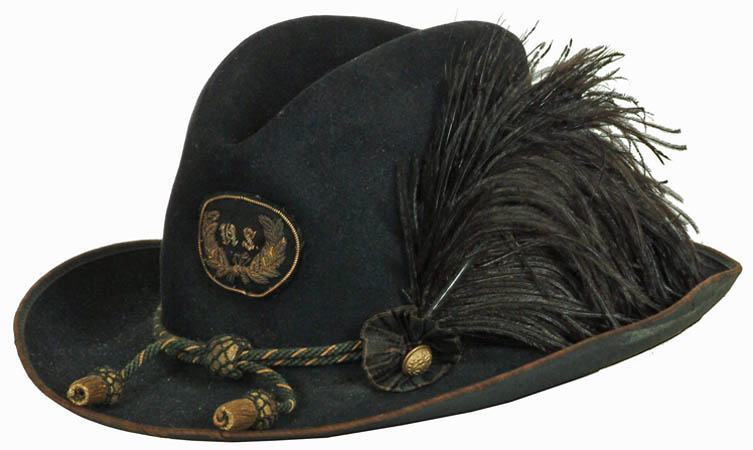Staff Officer's Headgear
Hat of Captain William R. Palmer
Staff Officer, U.S. Volunteers

Captain William R. Palmer's Hat (Courtesy: Mike Sorenson) |

Captain William R. Palmer's Hat (Courtesy: Mike Sorenson) |
Captain Palmer's hat is an example of the nonregulation headgear favored by Union officers for routine wear. The regulation officer's Jeff Davis hat was high crowned, stiff and by most accounts not that serviceable. On the other hand Palmer's hat was conformable and more serviceable.
The trimmings are similar to those of the regulation "Jeff Davis" hat. There is a black and gold officer's hat cord. On the front of the hat is a staff officer's U.S. wreath. The same insignia was also used by general officers. Rarely the letters "U.S." were replaced with those of a staff department. Lastly, a single ostrich feather is worn on the left side with a small cockade and staff button reinforcing its base. The majority of surviving hats lack feathers, but Palmer must have favored a more jaunty appearance. Unlike regulation trimmings his hat only has one feather rather than two called for by the regulations. Since the brim is not turned up on one side there was no need for the oval embroidered eagle insignia used for that purpose.
This style of hat is commonly referred to as a "slouch hat." The term actually appears in Webster's and is defined as "a soft, usually felt, hat with a wide flexible brim." Certainly, some officers' hats fit this definition exactly, but most have a rolled brim that was not that flexible. A major problem with terminology of Civil War headgear is that one might take a regulation Jeff Davis hat and a classical slouch hat and find another hundred period hats with characteristics somewhere in between the two. With the exception of the regulation Jeff Davis these hats were all one of a kind, hand made and selected according to the wearer's preference and not to any written specifications.
William R. Palmer was born in Rhode Island, but enlisted September 21, 1861 as a private in the 8th Connecticut Infantry Regiment. He must have been a man of some ability as he was detailed as the orderly to the regiment's colonel and later promoted the regiment's sergeant major, which is the senior most enlisted grade within a regiment. However, Palmer's career was not to be totally meteoric. He was lost his rank as a result of being absent without leave. This was not an unusual situation among volunteer troops and often might go unpunished. It is likely that the colonel felt his sergeant major failed to set a good example for the men and had to be dealt with severely.
We do not know just how Palmer accepted this turn of events, but it is interesting that he was discharged
to receive a commission as a second lieutenant in Company C of the 40th New York Infantry (Mozart Regiment) March 20, 1863 only a few months after he was busted.
The Mozart Regiment acquired its nickname after Mozart Hall, a New York City political faction, who was the rival of
the better known Tammany Hall faction and sponsors of the regiment. He was detailed as an aide-de-camp to General John Henry Hobart Ward. During the Civil War regimental officer could
be detailed from the line infantry to a staff position and returned at the pleasure of their commander. The 40th
New York served in the brigade commanded by General Ward.
On August 19th 1863 he was discharged from the 40th to accept a commission as a captain of U.S. Volunteers,
which are conferred on September 12, 1863. U.S. Volunteers were temporary members of the Regular Army,
who were given appointments in various staff departments.
Thanks to Mike Sorenson his help in researching material for this page.